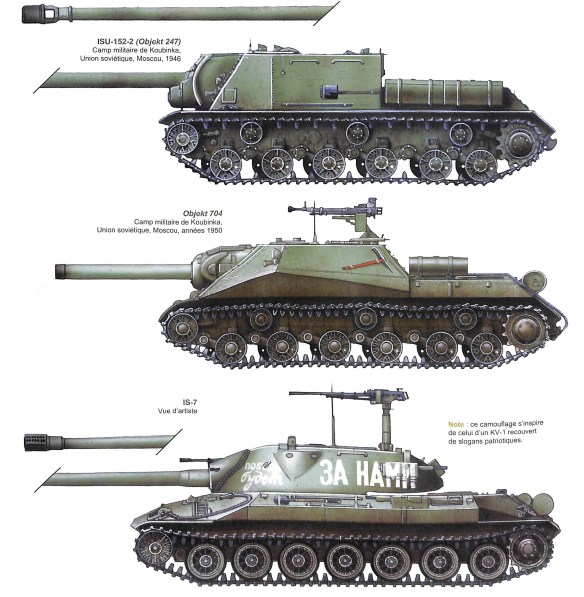Two versions of a prototype WWII Russian tank destroyer based on the ISU-152 assault gun. The goal was to field an anti-tank gun heavy enough to deal with the heavier German tanks like the Tiger II, JagdTiger and any potentially larger tanks the Russian thought might be in the works with the Germans. The first prototype ISU-152-1 (Object 246) was developed in April 1944 and mounted the BL-8 long barrel gun. Performance did not meet expectations so the gun was reworked. In August 1944 a second prototype ISU-152-2 (Object 247) replaced the BL-8 with the improved and slightly shortened BL-10. It was not accepted into service because the barrel’s service life was still not what designers wanted it to be. The penetrating power and accuracy still did not meet expectations so the gun was again sent back for improvements but the war ended before this was ever completed.
The Object 704 self propelled gun was a prototype tank utilising elements both the IS-2 and IS-3 tanks. It was designed to carry the 152.4 mm ML-20SM model 1944 gun-howitzer, with a barrel length of over 4.5 metres (29.6 calibers) and no muzzle brake. It had a maximum range of 13,000 metres. The self-propelled gun carried 20 rounds of two piece (shell and charge) armour-piercing and high explosive ammunition. The armour-piercing round, weighing 48.78 kg, had a muzzle velocity of 655 m/s. The rate of fire was 1-2 round/min. The secondary armament of the fighting vehicle consisted of two 12.7 x 108 mm DShK machine guns, one anti-aircraft and one co-axial.
In many ways it was superior to the ISU-152 with thicker and more well angled armour, without sacrificing much in terms of mobility which was comparable to the ISU-152. In some places, especially the mantlet, the armour thickness could reach 320mm making it the best protected Soviet Assault gun of WW2. Built in1945 at the Chelyabinsk Kirovsk Plant. One prototype was developed of Object 704, which is housed today at the Kubinka Tank Museum in Russia.
However, there were numerous issues that came with the tank. Notice in the picture that the gun lacked a muzzle brake. This noticeably increased the recoil of the gun. Combined with the sloped armour which reduced space in the fighting compartment, it significantly complicated the work for the crew.
This was the primary reason the tank wasn’t used. Although on paper, the tank looked superior to the ISU-152, it gained those advantages at the cost of ergonomics.
The Soviet Army continued to develop heavy tanks with even thicker armour. The most significant of them was the IS-3, which stemmed from the experience of the 1943 Battle of Kursk. This battle emphasized the importance of frontal armour and led to the design of the IS-3, which was in effect an IS-2 but with a ballistically much better-shaped turret and hull front. The armour of IS-3 was actually 120mm thick at the front of the hull, but because of the way it was angled it was equivalent to about 330mm against conventional armour-piercing projectiles, which was more than the armour of any tank produced before its appearance.
The development of the IS-3 started in 1944 and it was put into production with remarkable speed at the beginning of 1945. But only a few were completed by the time the war ended and so none saw any action in it. Production of it continued until 1959 and totalled 2,311 tanks.
The existence of the IS-3 was revealed to the outside world when 52 took part in the Allied Victory Parade in Berlin in September 1945. After the parade Marshal Zhukov, the Soviet commander in Germany, is reported to have told Stalin that IS-3 made a great impression on Western observers. In fact, the IS-3 came to be considered the principal threat to Western armies during the early days of the Cold War, and as `Stalin tanks’ they became something of a bogey. However, they suffered from various shortcomings including cracking of the welded joints between their armour plates, some of which was due to them being rushed into production, and they had to undergo a number of modifications that went on until the late 1950s. When they were eventually used in combat, they also proved less formidable than was expected. This was the case in 1956, when some were destroyed in the streets of Budapest during the Hungarian uprising, and when the Israeli forces destroyed or captured 73 of the 100 IS-3s the Egyptian Army employed during the Six Day War of 1967.
The IS-3 was followed after the Second World War by the development of other heavy tanks. First came the IS-4, which was also armed with a 122mm gun but had thicker frontal armour, as a result of which it weighed 60 tonnes compared with the 46.5 tonnes of the IS-3. It was produced from 1947 to 1949 but only about 200 are believed to have been built. Next came the IS-6, which was essentially an IS-4 but with an electric instead of a mechanical transmission. It proved a failure. The third tank to be built was the IS-7, which was armed with a more powerful 130mm gun based on a naval gun. It weighed 68 tonnes, which made it the heaviest tank built in the Soviet Union. Design of the IS-7 was begun in 1945 and a series of four was completed in 1948, but after accidents during trials further development of it was abandoned.
